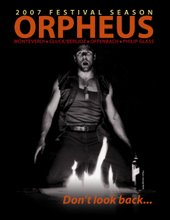Behind the Magic: Abby Rodd, Technical Director
Looking the finished product of a show, the audience only sees what’s out front—polished actors, beautiful costumes, a seamless set. Often audience members don't consider how these pieces come together—the business behind the magic. A good show keeps the audience so enthralled that they don’t need to think about it. Technical Director Abby Rodd, a 16-year veteran of Glimmerglass Opera, is in charge of the people who bring the show to life behind the curtain, working in the field of stage operations, carpentry, rigging, or scenic art. Here's an inside look at the world of stagecraft at Glimmerglass.
Technical Director Abby Rodd, a 16-year veteran of Glimmerglass Opera, is in charge of the people who bring the show to life behind the curtain, working in the field of stage operations, carpentry, rigging, or scenic art. Here's an inside look at the world of stagecraft at Glimmerglass.
Q: You’ve been here 16 years, since you were an intern in 1992. How has the company evolved since then?
Abby Rodd: There was no stage ops when I started. The carpenters ran the shows. We didn’t build any full sets in-house. I don’t know specific numbers, but I think [the size of the company] has at least doubled since I’ve been here. And the sizes of the shows and the sizes of the budgets have gone way up. But I came here knowing nothing. It was just a summer job, because I lived in Cooperstown.
Q: You said you were in charge of Stage Operations. What exactly is that?
AR: Stage Ops is a crew of 19 people and they do the changeovers from one show to the next. They're also there for running the shows and for bringing rehearsal scenery and props to rehearsal halls. They do all the fly cues and open the trapdoor.
Q: Fly cues—like flying people?
AR: We're not flying people this year—we were going to. When people do fly cues, they are pulling the ropes that make the sets fly in.
Q: So hell drops in?
AR: Well, not really. Mount Olympus comes down to cover up Earth, so the side walls come down. Then at the intermission, we change all of the walls for hell. There are essentially four sets. It works with a lot of counterweight. There are two side walls, so we have 2000 pounds of counterweight on the other side, so it’s an equal balance. So one person can fly rope and pull 2000 pounds.
Q: What do you use for the actual counterweights?
AR: They’re iron weights—they’re called pig-irons and they come in 25-40 pound bricks that we stack up on an arbor that holds it all. The rigging people install that rig and the Stage Ops people operate it under the riggers’ supervision.
Q: Shows are only running two months during the year. What is your schedule like during those two months—the official “season”?
AR: All four shows are only running for one month together. August is kind of an easy month for us. These two weeks here in June—teching the first two shows while we’re getting the third and fourth shows ready—are difficult. The weeks we’re in right now are probably the most difficult part of the summer.
Q: What about the “off-season,” September through April?
AR: Well, we started building the Glass in April. Before that, I was doing a lot of budgeting and drafting for that show and also the other shows. Two of the other shows were in contract shops being built. They started building in early February, so there were trips to where they were being built and lots of meetings. January is bidding out any contract shops and that tends to be a long process, because it never comes in on budget the first time. September’s sort of quiet, and then we start having preliminary planning meetings in October and November. We do shop maintenance and stuff. It’s a little bit more of a 9-to-5 job in the winter, until March.
Q: You mentioned drafting. John Conklin and the other production designers submit drafts for the shows. What sort of drafting do you do?
AR: They draw what it’s supposed to look like and I draw where the frame goes and how it all fits together and where—bolt-holes and where it needs to break to fit into the truck, where it needs to break to fit for storage.
Q: What would you say the biggest challenge is in coordinating these four very different shows?
AR: It’s different from year to year, really. [This year] we have a major storage issue. The stage is a specific size and we fill that four times. Our storage space to store everything in is smaller than that space, so we need to store three of those sets in the one smaller space. It all doesn’t really fit right now. Right now, the Offenbach is on stage, but we have a Gluck wall upstage and a Monteverdi wall on stage right—it’s just going to have to be there, because there’s nowhere else to put it. That’s not typical. We have more scenery this year than we’ve had ever here before, but we make it work; we just figure out how to fit things in. There’s a lot of stuff in the air—more lighting than scenery now.
Q: So you guys are the one who make the magic?
AR: I don’t think I make any magic happen. I make the set stand up.
Q: Well, that’s pretty useful.
AR: It’s more useful than lying down.
